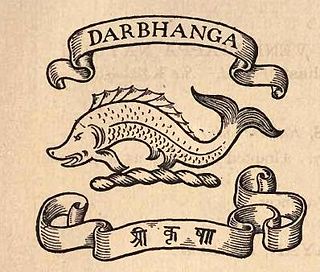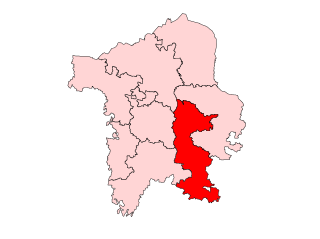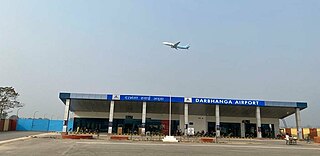
Darbhanga is the fifth largest city and municipal corporation in the state of Bihar in India, and is considered an important city in North Bihar. It serves as the headquarters of the Darbhanga district and the Darbhanga division. Darbhanga is also referred to as the gateway to Bengal, because it is held that the name Darbhanga has been derived from Dwār Banga or Dari – Banga, meaning the 'door of Bengal'.

Darbhanga district is one of the thirty-eight districts of Bihar state in eastern India, and Darbhanga city is the administrative headquarters of this district and 5th largest city of Bihar as well. Darbhanga district lies in Historical Mithila region. Darbhanga district is a part of Darbhanga Division. The district is bounded on the north by Madhubani district, on the south by Samastipur district, on the east by Saharsa district and on the west by Sitamarhi and Muzaffarpur districts. The district covers an area of 2,279 km2 (880 sq mi).

Darbhanga Division is an administrative geographical unit of Bihar state of India, and Darbhanga city is the administrative headquarters of the division. It is a part of historical Mithila region. The main language of the division is Maithili and Urdu included its dialects mostly spoken by Muslims. As of 2023, the division consists of Darbhanga district, Madhubani district, and Samastipur district.
Bairgania is a town and notified area in the Sitamarhi district in the state of Bihar, India. Bairgania is one of the blocks of Sitamarhi districts and is a border of India that links Nepal via Rautahat District through a custom checkpoint. Bairgania is the first town of India that is located on the bank of the Bagmati River.It has a good government medical hospital and experience doctors such as alumni from PMCH.

The Darbhanga Raj, also known as Raj Darbhanga and the Khandwala dynasty, was a Maithil Brahmin dynasty and the rulers of territories, not all contiguous, that were part of the Mithila region, now divided between India and Nepal. The rulers of Raj Darbhanga were Maithil Brahmins and their seat in the town of Darbhanga became the core of the Mithila region as the rulers were patrons of Maithil culture and the Maithili language.

Darbhanga Lok Sabha constituency is one of the 40 Lok Sabha (parliamentary) constituencies in Bihar state in eastern India. Currently Gopal Jee Thakur of Bhartiya Janta Party is the Member of Parliament from Darbhanga Loksabha. In 2024 Indian general election, Gopal Jee Thakur won from this constituency.

Bajpatti Assembly constituency is an assembly constituency in Sitamarhi district in the Indian state of Bihar.

26°02′44″N86°06′33″E

Darbhanga Rural is an assembly constituency in Darbhanga district in the Indian state of Bihar. It has been an open seat since 2010 but was earlier reserved for scheduled castes.

Darbhanga Assembly constituency is an assembly constituency in Darbhanga district in the Indian state of Bihar.

Bahadurpur Assembly constituency is an assembly constituency in Darbhanga district in the Indian state of Bihar.

Jale is an assembly constituency in Darbhanga district in the Indian state of Bihar.
Bahera Assembly constituency was an assembly constituency in Darbhanga district in the Indian state of Bihar.
Abdul Bari Siddiqui is an Indian politician who was the Finance Minister of Bihar. He was a MLA representing Alinagar, Darbhanga, Bihar. Siddiqui is a member of the Rashtriya Janata Dal political party. He won in the 2015 Bihar Legislative Assembly election. In 2019 Loksabha elections he contested from Darbhanga and lost to Gopal Jee Thakur of BJP by a margin of 2,67,979 votes.

Darbhanga Medical College and Hospital is a government medical college having multiple healthcare facilities and is located in Darbhanga, Bihar. It was established in the year 1923. It is ranked 3rd in Bihar and 94th in India by IIRF 2023 ranking. College is currently affiliated with Bihar University of Health Sciences.

Antour is a village in Benipur Subdivision, Alinagar Block under Darbhanga district in Bihar state, in northeastern India. It is located 28 km towards East from District headquarters Darbhanga. 5 km from Alinagar. 138 km from State capital Patna. Antour Pin code is 847103 and postal office in Antour itself. This Place is in the border of the Darbhanga District and Madhubani District. Madhubani District Lakhnaur is North towards this place. Antour is famous for Panchlal Mahadev Mandir - five Shivlings.

Jaynagar railway station is a main terminal railway station in Madhubani district, Bihar. Its code is JYG. It serves Jainagar and the surrounding areas. The station consists of 5 platforms.
Janakpur Road railway station is a small railway station in Sitamarhi district, Bihar. Its code is JNR. It serves Janakpur Road town. The station consists of 2 platforms. It's B category railway station of Samastipur railway division.

Darbhanga Airport is a domestic airport and an Indian Air Force Station, serving Darbhanga, Bihar, India. It is located just at the outskirts of the city near the NH-527B and NH-57 highways, which passes through Darbhanga. The airport is operated by the Airports Authority of India (AAI). The foundation stone for the airport was laid by the then Chief Minister of Bihar, Nitish Kumar, and the then Civil Aviation Minister, Suresh Prabhu, in the presence of the State Civil Aviation Minister, Jayant Sinha, on 24 December 2018. After efforts taken by the then Civil Aviation Minister, Hardeep Singh Puri. Commercial flights started on 8 November 2020.

Gopal Jee Thakur is an Indian Politician from the Bharatiya Janata Party, and a Member of Parliament representing Darbhanga in Bihar, India.
















